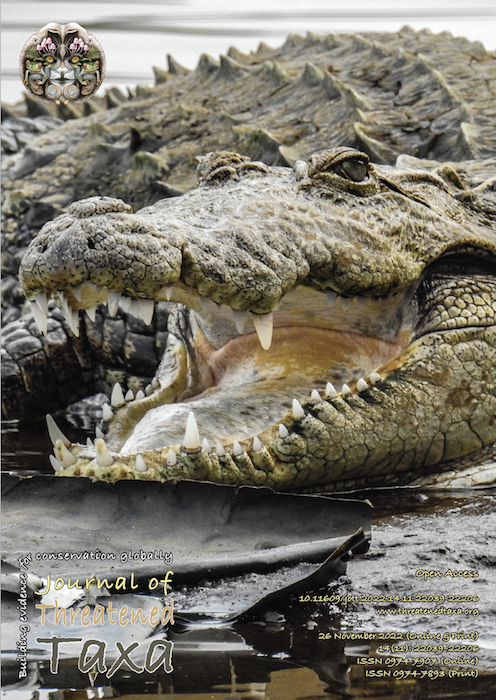Notes on the nesting and foraging behaviours of the Common Coot Fulica atra in the wetlands of Viluppuram District, Tamil Nadu, India
Main Article Content
Abstract
The nesting and foraging behaviours of the Common Coot Fulica atra were studied in the wetlands of Viluppuram District, Tamil Nadu during the breeding season. A total of 4,054 individuals of Common Coot including 467 juveniles and 1,327 nests were enumerated. Of the 1,327 nests, 1,191 were built on Ipomoea carnea vegetation and 136 on open water. The birds used twigs of Ipomoea carnea and various parts of eight other plant species as nest material. The nests were elliptical in shape, with flattened upper surfaces containing nest cup and a ramp-like structure each. 49.96 % of nests were found within 50 m distance from the edge of wetlands. A total of 16 plant species were identified as food sources including five algal species, such as Aphanothece stagnina, Spirogyra irregularis, Chara flaccida, C. vulgaris, and C. zeylanica. The Common Coots maintained strict territory during the breeding season and no other water birds were observed in the vicinity of their nesting and foraging sites. Even after completion of the breeding season, sporadic nesting was observed by a few pairs till June 2022.
Article Details

This work is licensed under a Creative Commons Attribution 4.0 International License.
Authors own the copyright to the articles published in JoTT. This is indicated explicitly in each publication. The authors grant permission to the publisher Wildlife Information Liaison Development (WILD) Society to publish the article in the Journal of Threatened Taxa. The authors recognize WILD as the original publisher, and to sell hard copies of the Journal and article to any buyer. JoTT is registered under the Creative Commons Attribution 4.0 International License (CC BY), which allows authors to retain copyright ownership. Under this license the authors allow anyone to download, cite, use the data, modify, reprint, copy and distribute provided the authors and source of publication are credited through appropriate citations (e.g., Son et al. (2016). Bats (Mammalia: Chiroptera) of the southeastern Truong Son Mountains, Quang Ngai Province, Vietnam. Journal of Threatened Taxa 8(7): 8953–8969. https://doi.org/10.11609/jott.2785.8.7.8953-8969). Users of the data do not require specific permission from the authors or the publisher.
References
Allouche, L. & A. Tamisier (1984). Feeding convergence of gadwall, coot and other herbivorous waterfowl species wintering in the Camargue: a preliminary approach. Wildfowl 35: 135–142.
Balachandran, C. (1994). Breeding records of Coot (Fulica atra Linn.) in south Tamil Nadu, India. Journal of the Bombay Natural History Society 91(2): 314.
Barve, S., T.R.S. Raman, A. Datta & G. Jathar (2020). When and how to study the nesting biology of Indian birds: Research needs, ethical considerations, and best practices. Indian BIRDS 16(1): 1–9.
Bibby, C. J., N.D. Burgess, D.A. Hill & S.M. Mustoe (2000). Bird census techniques. 2nd edition. Academic Press, London, UK, 614pp.
BirdLife International (2019). Fulica atra. The IUCN Red List of Threatened Species 2019:e.722692913A154269531 (Accessed on 11 May 2022).
Draulans, D. & L. Vanherck (1987). Food and foraging of Coot Fulica atra on fish ponds during autumn migration. Wildfowl 38: 63–69.
El-Yamine, G., N. Yassine, B. Choayb, B. Ettayib, H. Soumia & H. Moussa (2014). Breeding ecology of the Common Coot (Fulica atra) at El-Golea Lake (Algerian Sahara). World Journal of Environmental Biosciences 7(1): 48–51.
Gill, F., D. Donsker & P. Rasmussen (eds.) (2020). Flufftails, finfoots, rails, trumpeters, cranes, limpkin. IOC World Bird List (Version 10.1. International Ornithology Union (Accessed on 10 June 2022).
Hilt, S. (2006). Recovery of Potamogeton pectinatus L. stands in a shallow eutrophic lake under extreme grazing pressure. Hydrobiologia 570: 95–99. DOI: https://doi.org/10.1007/s10750-006-0167-3
Himmatsinhji, M.K., S.N. Varu & N.N. Bapat (1991). Occurrence, status and breeding of Podiceps cristatus (Linn.) and Fulica atra Linn. Journal of the Bombay Natural History Society 88(3): 439–441.
Howes, J.R. & M.R. Perrow (1994). Macrophyte grazing by coot in the boards: bird-resource interactions. In. Pitt, J.A. & G.L.Phillips (eds.), The Development of Biomanipulation Techniques & Control of Phosphorus Release from sediments. EC LIFE project 92-3/UK/031, NRI Report No.475121A. National River Authority/Boards Authority, Bristol, UK.
Khacher, L. (1978). The Coot Fulica atra (Linn.) nesting near Nasik, Maharashtra. Journal of the Bombay Natural History Society 74(3): 525.
Martin, R.P., J.H. Schutten, R.H. John, T. Holzer, F.J. Madgwick & J.D.J. Adian (1997). Interactions between coot (Fulica atra) and submerged macrophytes: the role of birds in the restoration process. Hydrobiologia 342/343: 241–255. DOI: https://doi.org/10.1007/978-94-011-5648-6_26
Nadarajan, N.R., P.A. Azeez & C.R. Ajithkumar (1993). The Coot Fulica atra (Linn.) breeding further south in the Indian peninsula. Journal of the Bombay Natural History Society 90(2): 289-290.
Nieoczym, M. & J. Kloskowski (2018). Habitat selection and reproductive success of Coot Fulica atra on ponds under different fish size and density condition. Hydrobiologica 820: 267–279. DOI: https://doi.org/10.1007/s10750-018-3664-2
Patel, S.B., A.D. Patel, G.Sharma, R.B. Chauhan & B.N. Parasharya (1998). Recent records of the Coot, Fulica atra, Breeding in Gujarat. Pavo 36(1 & 2): 124.
Samraoui, F. & B. Samraoui (2007). The reproductive ecology of the Coot Fulica atra L. in the Hauts Plateaux, northeast Algeria. Waterbirds 30: 133–139. DOI: https://doi.org/10.1675/1524-4695(2007)030[0133:TREOTC]2.0.CO;2
Santharam, V. (1996). Comments on some new bird records from Tamil Nadu. Journal of the Bombay Natural History Society 99(3): 589–590.
Taylor, B. (1998). Rails: A Guide to the Rails, Crakes, Gallinules and Coots of the World. Pica Press, Sussex, 600 pp.
Viluppuram (2021). Government of Tamil Nadu: Viluppuram District Website.
https://www.viluppuram.nic.in [Accessed on 10 June 2022].
Wang, J.S., S.Q. Zhang, J.S. Liu, C.J. Yang & B.C. He (1990). The breeding ecology of the Common Coot. Journal of Zoology 25(3): 24–29.
Zhang, W., T. Liu, K. Cheng & P. Rummy (2018). Declining water depth delayed the breeding time of Fulica atra, not human disturbance. PLoS ONE 13(8): e0202684. https://doi.org/10.1371/journal.pone. 0202684 DOI: https://doi.org/10.1371/journal.pone.0202684
Zhang, W.W. & J.Z. Ma (2011). Breeding behaviour of Common Coot (Fulica atra). Chinese Journal of Ecology 30(8): 1686–1690.

